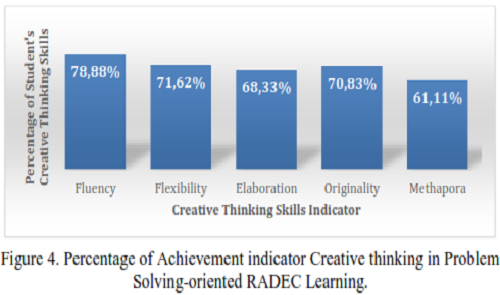
Implementation of Problem-Solving Oriented RADEC Learning Model in Colloidal Material for the Emergence of Creative Thinking Skills of High School Students
Abstract
Keywords
Full Text:
PDFReferences
Anwar, M. N., Shamim-ur-Rasool, S., & Haq, R. (2012). A Comparison of Creative Thinking Abilities of High and Low Achievers Secondary School Students. International Interdisciplinary Journal of Education, 1(1), 1-6.
Canelas, D. A., Hill, J. L., & Novicki, A. (2017). Cooperative Learning in Organic Chemistry Increases Student Assessment of Learning Gains in Key Transferable Skills. Chemistry Education Research and Practice, 18(3), 441-456.
Florida, R., Mellander, C., & King, K. (2015). The global creativity index 2015. Martin Prosperity Institute.
Fraenkel, J. R., Wallen, N. E., & Hyun, H. H. (2012). How to design and evaluate research in education (Vol. 7, p. 429). New York: McGraw-hill.
Hayati, D. K., Sutrisno, S., & Lukman, A. (2014). Pengembangan Kerangka Kerja Tpack pada Materi Koloid untuk Meningkatkan Aktivitas Pembelajaran dalam Mencapai Hots Siswa. Edu-Sains: Jurnal Pendidikan Matematika dan Ilmu Pengetahuan Alam, 3(1).
Herlanti, Y. (2014). Tanya Jawab Seputar Penelitian Pendidikan Sains: Jawaban atas Pertanyaan-Pertanyaan Mahasiswa Tingkat Akhir yang Sering Muncul dalam Penelitian Pendidikan Sains. Yanti Herlanti.
Hidayat, T., Susilaningsih, E., & Kurniawan, C. (2018). The Effectiveness of Enrichment Test Instruments Design to Measure Students’ Creative Thinking Skills and Problem-Solving. Thinking Skills and Creativity, 29, 161-169.
Johnson, E. B. (2010). Contextual Teaching & Learning Menjadikan Kegiatan Belajar Mengajar Mengasyikkan dan Bermakna. Bandung: Kaifa.
Küçükoğlu, H. (2013). Improving Reading Skills Through Effective Reading Strategies. Procedia-Social and Behavioral Sciences, 70, 709-714.
Mislinawati, M., & Nurmasyitah, N. (2018). Kendala Guru dalam Menerapkan Model-Model Pembelajaran Berdasarkan Kurikulum 2013 pada SD Negeri 62 Banda Aceh. Jurnal Pesona Dasar, 6(2).
Murphy, C., Scantlebury, K., & Milne, C. (2015). Using Vygotsky’s Zone of Proximal Development to Propose And Test an Explanatory Model for Conceptualising Coteaching In Pre-Service Science Teacher Education. Asia-Pacific Journal of Teacher Education, 43(4), 281-295.
Novilia, L., Iskandar, S. M., & Fajaroh, F. (2016). Pengembangan Modul Pembelajaran Dengan Pendekatan Inkuiri Terbimbing Pada Materi Koloid di SMA. Jurnal Pendidikan Sains, 4(3), 95-101.
Pourhosein Gilakjani, A., & Sabouri, N. B. (2016). How Can Students Improve Their Reading Comprehension Skill. Journal of Studies in Education, 6(2), 229.
Rakhmadani, N., Yamtinah, S., & Utomo, S. (2013). Pengaruh Penggunaan Metode Tgt Berbantuan Media Teka-Teki Silang dan Ular Tangga D Dengan Motivasi Belajar Terhadap Prestasi Siswa pada Materi Koloid Kelas XI SMA Negeri 1 Suro Tahun Pelajaran 2011/2012. Jurnal Pendidikan Kimia, 2(4), 190-197.
Riduwan, S. (2017). Pengantar Statistika untuk Penelitian: Pendidikan, Sosial, Komunikasi, Ekonomi, dan Bisnis. Bandung: Alfabeta.
Siregar, L. S. (2019). Desain Pembelajaran Polimer Menggunakan Model Read, Answer, Discuss, Explain Dan Create (RADEC) Berbasis Google Classroom Untuk Mengembangkan Penguasaan Konsep Dan Kreativitas Siswa Smk Pada Pembuatan Bioplastik (Doctoral dissertation, Universitas Pendidikan Indonesia).
Sopandi, W. (2017). The Quality Improvement of Learning Processes and Achievements Through The Read-Answer-Discuss-Explain-and Create Learning Model Implementation. In Proceeding 8th Pedagogy International Seminar (Vol. 8, pp. 132-139).
Sopandi, W. (2019). Sosialisasi dan Workshop Implementasi Model Pembelajaran RADEC Bagi Guru-Guru Pendidikan dasar dan Menengah. Pedagogia: Jurnal Pendidikan, 8(1), 19-34.
Sulfia, U., & Habibati, H. (2017). Penerapan Media Teka-Teki Silang pada Materi Koloid untuk Meningkatkan Hasil Belajar Peserta Didik. JIPI (Jurnal IPA & Pembelajaran IPA), 1(1), 6-15.
Susetyo, B. (2014). Statistika untuk Analisis Data Penelitian. Bandung: PT. Refika Aditama.
Tawil, M., & Haris, A. (2016). Analisis Keterampilan Berpikir Kreatif Fisika pada Peserta Didik Kelas XI IPA1 SMA Negeri 2 Bua Ponrang. Jurnal Pendidikan Fisika, 4(1), 127-144.
Utami, W. S., Ramli, M., Ariyanto, J., & Riyanto, B. (2018). Memperbaiki Kemampuan Berpikir Kreatif Siswa melalui Problem Based Learning dan Creative Problem-Solving Process di Pelajaran Biologi. In Proceeding Biology Education Conference: Biology, Science, Enviromental, and Learning (Vol. 15, No. 1, pp. 082-089).
Van Uum, M. S., Verhoeff, R. P., & Peeters, M. (2017). Inquiry-Based Science Education: Scaffolding Pupils’ Self-Directed Learning in Open Inquiry. International Journal of Science Education, 39(18), 2461-2481.
Wahab, A., Syahid, A., & Junaedi, J. (2021). Penyajian Data dalam Tabel Distribusi Frekuensi dan Aplikasinya pada Ilmu Pendidikan. Education and Learning Journal, 2(1), 40-48.
Zubaidah, S., Fuad, N. M., Mahanal, S., & Suarsini, E. (2017). Improving Creative Thinking Skills of Students Through Differentiated Science Inquiry Integrated With Mind Map. Journal of Turkish Science Education, 14(4), 77-91.
DOI: http://dx.doi.org/10.31258/jes.7.3.p.400-415
Refbacks
- There are currently no refbacks.
Copyright (c) 2023 Ida Khaerunnisah -

This work is licensed under a Creative Commons Attribution 4.0 International License.
Publisher: FKIP Universitas Riau












